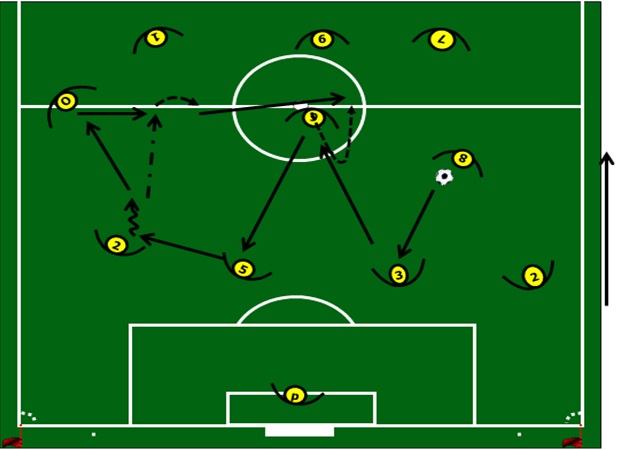When a ball reaches a player in the center lane (center forward, midcenter, center...), from a side lane in which 4/5 touches have been made, this player must (depending on the time the ball was handled in this side lane):
|
Graphic

Considerations
- In the progression zone, four or more touches have been made in the same lane, without reaching the completion zone with the possibility of completion, implies a time that is taken advantage of by the opposing team to swing towards that area, thus eliminating the spaces necessary to maintain possession of the ball.
- The orientation changes will not only prevent the loss of the ball in the demarcation in which the 4/5 touches have previously been made (or in which it has been recovered), but will allow in the opposite demarcation (where there are free spaces) to reach the end zone with a manifest advantage.
- The change of orientation must be done with power and precision (directly or indirectly – triangulating with a partner of another line-), while receptions must be made by orienting the ball and playing it at two touches (reception-pass), so that the opposite cannot rectify its position towards the free spaces before the arrival of the ball.
- For this action to be effective, balance must be constantly manifested in and between lines (amplitude and depth), with players on the line being maintained equidistant from each other.
- The orientation changes may be:
- Direct (Towards a player of the same line).
- Indirect (triangulating with a partner from another line). More effective in causing the "fixation" and attention of the opposing defender towards this area in this first pass and the reception of the partner in second play (time/space).
- Long (change of orientation high in depth when there are no spaces to handle the ball in short and / or large spaces have been created in the opposite area of the holder.
Aimed at
Tip, Midcenter/Pivot, Half Point and Central.
Training goals
Correct implementation of the slogan and the consequent use of space-time factors
Videos
VIDEO (FU1i): The holder's game in the center lane INCORRECT MANIFESTATION
VIDEO (FU1c): The holder's game in the center lane MANIFESTATION CORRECT
